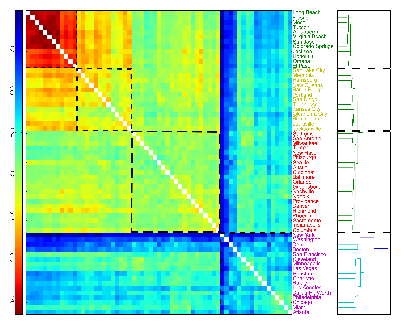The Top Five Trend-Setting Cities on Twitter
One of the defining properties of social networks is the ease with which information can spread across them. This flow leads to information avalanches in which videos or photographs or other content becomes viral across entire countries, continents and even the globe.

It’s easy to imagine that these trends are simply the result of the properties of the network. Indeed, there are plenty of studies that seem to show this.
But in recent years, researchers have become increasingly interested in the relationship between a network and the geography it is superimposed on. What role does geography play in the emergence and spread of trends? And which areas are trend setters and which are trend followers?
Today we get an answer of sorts thanks to the work of Emilio Ferrara and pals at Indiana University in Bloomington. These guys have examined the way trends emerge in cities across the US and how they spread to other cities and beyond.
Their research allows them to classify US cities as sources, those that lead the way in trends, or those that follow the trends which the team call sinks.
Their research also leads to a curious conclusion–that air travel plays a crucial role in the spread of information around the country This implies that trends spread from one part of the country to another not over the internet but via air passengers, just like diseases.
The method these guys use is straightforward. Twitter publishes a continuously updated list of the the top ten most popular phrases or hashtags on its webpage. It also has webpages showing the trending topics for each of 63 US cities.
To capture the way these trends emerge and spread, Ferrra and co set up a web crawler to check each list every ten minutes between 12 April and 30 May 2013. In this way the collected over 11,000 different phrases and hashtags that became popular throughout these 50 days.
They then plotted the evolution of these trends in each US city over time. This allowed them to study how trends spread from one city to another and to look for clusters of cities in which the same topics trend together.
The results are revealing. They say most trends die away quickly–around 70 per cent of trends last only 20 minutes and only 0.3 per cent last more than a day.
Ferrara and co say they can see three distinct geographical regions that share similar trends–the East Coast, the Midwest and Southwest. It’s easy to imagine how trends arise at a low level and spread through the region through local links such as friends.
But these guys say there is also a fourth cluster of influential cities that also form a group where the emergence of trends is related. However, these places are not geographically related. They are metropolitan areas such as Los Angeles, New York, Atlanta, Chicago and so on.
What links these places is not geography but airports, say Ferrara and co. Their hypothesis is that topics trend in these places because of the influence of air passengers. In other words, trending topics spread just like diseases.
Ferrara and co have created a list of the cities that act as trend setters and those that act as trend followers.
The top five sources of trends are: Los Angeles, Cincinnati, Washington, Seattle and New York.
The top five trend followers (or sinks) are: Oklahoma City, Albuquerque, El Paso, Omaha and Kansas City.
That’s a fascinating result. In a sense it’s obvious that the large scale movement of people will influence the spread of information However, it’s not obvious that this should happen at a rate that is comparable to the spread of trends across the internet itself.
And it raises an interesting question that Ferrara and co hope to answer in future work. “Does information travel faster by airplane than over the Internet?” they ask.
We’ll be watching for when they reveal the answer.
Ref: arxiv.org/abs/1310.2671 : Traveling Trends: Social Butterflies or Frequent Fliers?
Keep Reading
Most Popular
Large language models can do jaw-dropping things. But nobody knows exactly why.
And that's a problem. Figuring it out is one of the biggest scientific puzzles of our time and a crucial step towards controlling more powerful future models.
The problem with plug-in hybrids? Their drivers.
Plug-in hybrids are often sold as a transition to EVs, but new data from Europe shows we’re still underestimating the emissions they produce.
Google DeepMind’s new generative model makes Super Mario–like games from scratch
Genie learns how to control games by watching hours and hours of video. It could help train next-gen robots too.
How scientists traced a mysterious covid case back to six toilets
When wastewater surveillance turns into a hunt for a single infected individual, the ethics get tricky.
Stay connected
Get the latest updates from
MIT Technology Review
Discover special offers, top stories, upcoming events, and more.